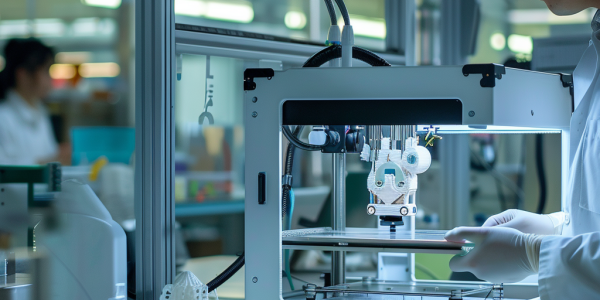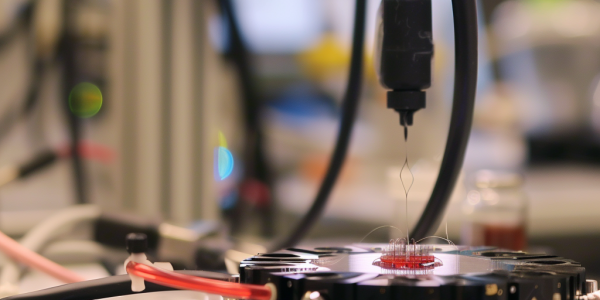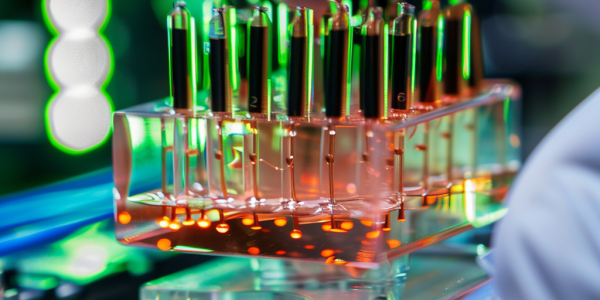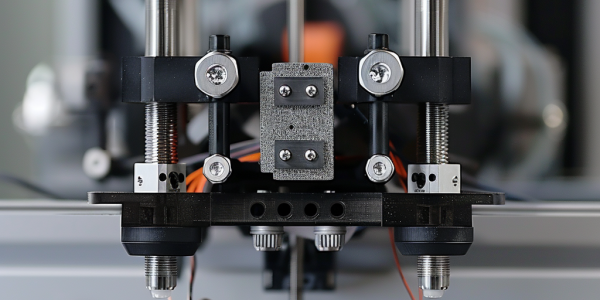MIT Researchers Unveil Dual-Action Cancer Therapy Combining Phototherapy and Chemotherapy
MIT researchers have developed a groundbreaking dual-action cancer therapy that combines phototherapy and chemotherapy into a single implant. This innovative approach aims to enhance treatment effectiveness while minimizing side effects for patients with advanced tumors. Early studies show promising results, potentially paving the way for more personalized and effective cancer treatments.
MIT Advances 3D-Printed Active Electronics, Paving Way for Semiconductor-Free Manufacturing
MIT researchers have made groundbreaking advancements in 3D-printed active electronics, introducing semiconductor-free logic gates that could revolutionize electronics manufacturing. This innovation aims to democratize technology, allowing individuals and businesses to create their own electronic devices, reducing dependency on traditional semiconductor processes. With the potential to transform various industries, this research paves the way for more accessible and sustainable manufacturing solutions.
MIT Engineers Develop Groundbreaking Method to Protect Microbes from Extreme Conditions
MIT engineers have developed a groundbreaking method to protect microbes from extreme conditions, enhancing their resilience with FDA-approved food and drug additives. This innovative technique has enabled microbes to withstand high temperatures, radiation, and industrial processing, with potential applications in space missions, human health, and agriculture.
MIT Engineers Develop Implantable Ultrasound Device for Neurological Disorders
MIT engineers have developed the ImPULS device, an implantable ultrasound technology that could revolutionize the treatment of neurological disorders like Parkinson’s disease. This groundbreaking device offers a minimally invasive alternative to traditional deep brain stimulation, potentially reducing tissue damage and increasing treatment efficacy. The device, as thin as a human hair, uses ultrasound instead of electricity for deep brain stimulation, showing promising results in triggering dopamine release. This innovation not only has therapeutic applications but also holds promise for advancing neuroscience research.
MIT Engineers Develop Groundbreaking Computer Vision Method for Characterizing Electronic Materials
MIT engineers have developed a groundbreaking computer vision method for rapid characterization of electronic material properties, significantly outpacing traditional approaches. This innovative technique aims to expedite the discovery of superior electronic materials for applications such as solar cells, transistors, LEDs, and batteries. The method accelerates the characterization process by an impressive 85 times, revolutionizing the evaluation of freshly synthesized electronic materials.
Revolutionary Lead Detection Technology Developed by MIT Engineers
A recent breakthrough in lead detection technology has resulted in the development of a compact and cost-effective device that can accurately measure lead concentrations in water. With approximately 240 million individuals worldwide exposed to unsafe levels of lead in drinking water, this innovation offers a promising solution to the pressing public health issue. The device, utilizing a photonic chip and crown ethers, can detect lead levels as low as 15 parts per billion, meeting current EPA standards for safe drinking water.
New Autonomous 3D Printer Revolutionizes Parameter Creation for Unknown Materials
A groundbreaking development in 3D printing has emerged as scientists introduce a new FDM 3D printer capable of autonomously creating parameters for unknown materials. This innovation, spearheaded by experts from MIT’s Center for Bits and Atoms, NIST, and Demokritos, aims to revolutionize sustainable 3D printing practices. By developing an extruder that gathers filament data during printing, the team has successfully implemented a mathematical model to determine optimal printing parameters for various materials. This advancement holds the potential to enhance the utilization of unique FDM filaments with superior sustainability compared to conventional polymers.
MIT Researchers Make Groundbreaking Discovery of Neutronic Molecules
MIT researchers have made a groundbreaking discovery of ‘neutronic molecules,’ revealing that neutrons can bind to nanoscale atomic clusters known as quantum dots. This finding could offer valuable insights into material properties and quantum effects, potentially leading to the development of innovative tools for exploring quantum-level phenomena. Unlike protons and electrons, neutrons are subatomic particles that lack electric charge, making them impervious to the electromagnetic force that governs most interactions between radiation and materials. However, MIT researchers have now demonstrated that neutrons can be induced to adhere to quantum dots—comprising tens of thousands of atomic nuclei—solely through the strong force. This unexpected revelation opens up new possibilities for investigating material properties at the quantum level, particularly those stemming from the strong force, and for exploring novel forms of quantum information processing devices.
MIT Unveils New AI Framework for High-Speed Image Generation
MIT researchers have unveiled a new AI framework, DMD, that can generate high-quality images 30 times faster than traditional methods. This breakthrough in artificial intelligence streamlines the image generation process into a single step while maintaining or enhancing image quality, revolutionizing visual content creation and opening up new possibilities for various industries.
MIT Achieves Precise Control of Ultrathin Magnet at Room Temperature
MIT researchers achieve precise control of an ultrathin magnet at room temperature, paving the way for faster and more efficient processors and computer memories. This breakthrough could lead to magnetic-based devices consuming less energy than traditional silicon-based devices, offering unprecedented speed, efficiency, and scalability. The researchers utilized pulses of electrical current to switch the direction of the device’s magnetization at room temperature, harnessing the fundamental property of electrons called spin. This development is crucial as it makes magnets composed of atomically thin van der Waals materials practical for use outside a laboratory setting.










